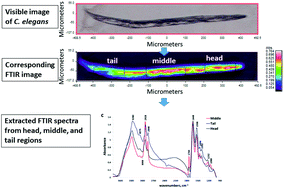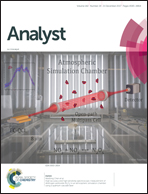FTIR imaging detects diet and genotype-dependent chemical composition changes in wild type and mutant C. elegans strains†
Abstract
This study focuses on the use of Fourier Transform Infrared (FTIR) microspectroscopy to determine chemical changes induced in the nematode Caenorhabditis elegans by supplementation of C. elegans maintenance media (CeMM) by Eicosapentaenoic acid (EPA). Wild-type C. elegans (N2) and mutant strains (tub-1 and fat-3) were grown in CeMM alone, and CeMM supplemented with EPA at 25 or 100 μM. Feeding was performed for 72 h. FTIR imaging was performed in transmission mode on individual worms. The FTIR imaging analysis of wild-type animals revealed the presence of vibrations assigned to unsaturated fatty acids, specifically bands at 3008 cm−1 (![[double bond, length as m-dash]](https://www.rsc.org/images/entities/char_e001.gif) C–H, olefinic stretch) and 1744 cm−1 (C
C–H, olefinic stretch) and 1744 cm−1 (C![[double bond, length as m-dash]](https://www.rsc.org/images/entities/char_e001.gif) O, unsaturated fatty acids). It confirmed previously reported synthesis of unsaturated fatty acids in wild-type C. elegans. For the FTIR spectra of mutant strains, these vibrations were absent or present only as very small shoulder, which indicates that tub-1 and fat-3 synthesize essentially saturated fatty acids as indicated by the presence of –CH2 and C
O, unsaturated fatty acids). It confirmed previously reported synthesis of unsaturated fatty acids in wild-type C. elegans. For the FTIR spectra of mutant strains, these vibrations were absent or present only as very small shoulder, which indicates that tub-1 and fat-3 synthesize essentially saturated fatty acids as indicated by the presence of –CH2 and C![[double bond, length as m-dash]](https://www.rsc.org/images/entities/char_e001.gif) O vibrations. These results are in agreement with previous studies which reported that these mutants have altered lipid compositions. Principal component analysis showed differences in chemical composition between wild-type and mutant strains as well as between mutant strains cultured in normal CeMM and those cultured in CeMM supplemented with EPA. This study demonstrated the usefulness of FTIR microspectroscopy to investigate fat metabolism in C. elegans.
O vibrations. These results are in agreement with previous studies which reported that these mutants have altered lipid compositions. Principal component analysis showed differences in chemical composition between wild-type and mutant strains as well as between mutant strains cultured in normal CeMM and those cultured in CeMM supplemented with EPA. This study demonstrated the usefulness of FTIR microspectroscopy to investigate fat metabolism in C. elegans.



 Please wait while we load your content...
Please wait while we load your content...